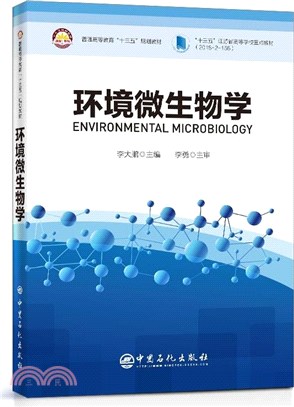商品簡介
作者簡介
名人/編輯推薦
本教材入選2018年江蘇省高等學校重點教材立項建設。教材由蘇州科技大學環境微生物學教學組編寫,編寫組融合了具有微生物、水處理、生態學等背景的7名教師,具有10多年的豐富教學經驗。教材從工程視角入手,圍繞微生物的分類、進化、生長繁殖、馴化、生態學、分子生物學等基礎知識和前沿熱點,結合環境治理領域的不同技術體系,著力突出環境治理工程對微生物學的需要。教材的出版,將為以工程應用創新能力培養為主題的高等院校環境類專業學生提供適宜的教材,強化環境類專業學生微生物知識水平,並提升專業英語水平。
目次
Chapter 1 Introduction 7
1.1 Environmental Microbiology as a Discipline 7
1.2 Presence of Microbes in Our lives 9
1.2.1 Microbes in Our Body 9
1.2.2 Microbes in the Atmosphere 9
1.2.3 Microbes in Soil 10
1.2.4 Microbes in Water 10
1.2.5 Microbes of Plants 11
1.2.6 Microbes of Animal Origin 11
1.3 An Historical Perspective 12
1.4 Modern Environmental Microbiology 14
Chapter 2 Non-cellular Life: Viruses 18
2.1 General Characteristics and Classification of Viruses 18
2.1.1 Characteristics of viruses 18
2.1.2 Classification of viruses 18
2.2 Virus Morphology and Structure 19
2.2.1 Morphology and size of virus 20
2.2.2 Chemical composition and structure of virus 20
2.3 Virus Propagation 22
2.3.1 Reproduction process of virus 22
2.3.2 Lysogenicity of virus 23
2.4 Virus Cultivation 24
2.4.1 Culture characteristics of viruses 24
2.4.2 Culture medium for viruses 25
2.4.3 The cultivation of viruses 25
2.5 Resistance to Physical and Chemical Affects and Removal of Virus from Sewage Treatment Processes 27
2.5.1 Resistance of virus to physical factors 27
2.5.2 Resistance of virus to chemical factors 28
2.5.3 Viruses resistant to antibacterial substances 29
2.5.4 Virus survival in environment and its removal in sewage treatment process 29
Chapter 3 Prokaryotic Microorganisms 32
3.1 Bacteria 32
3.1.1 Morphology and size of bacteria 32
3.1.2 Cell structure of bacteria 40
3.1.3 Characteristics of bacterial culture 49
3.1.4 Physical and chemical properties of bacteria 52
3.2 Archaea 56
3.2.1 Characteristics of archaea 57
3.2.2 Classification of archaea 58
3.3 Actinomycetes 61
3.3.1 Morphology and size of actinomycete 62
3.3.2 Colony morphology of actinomycetes 64
3.3.3 Actinomycetes reproduction 64
3.4 Cyanobacteria 64
3.4.1 Chroococcophyceae 66
3.4.2 Hormogonophyceae 66
3.5 Spirochete 66
3.6 Rickettsia and Mycoplasma 67
3.6.1 Rickettsia 67
3.6.2 Mycoplasma 67
Chapter 4 Eukaryotic Microorganism 69
4.1 Protozoa 69
4.1.1 General characteristics of protozoa 69
4.1.2 Classification of protozoa 70
4.1.3 Cyst of protozoa 77
4.2 Miniature Metazoa 77
4.2.1 Rotifer 77
4.2.2 Nematode 79
4.2.3 Oligochaetes 79
4.2.4 Crustacean plankton 79
4.2.5 Bryozoan and Plumatella 80
4.3 Algae 81
4.3.1 General characteristics of algae 81
4.3.2 Classification and characteristics of algae 81
4.4 Fungus 87
4.4.1 Yeast 87
4.4.2 Mold 91
4.4.3 Agaricales 96
Chapter 5 Microbial metabolism 98
5.1 Overview of microbial metabolism 98
5.2 Microbial enzymes and enzymatic reactions 98
5.2.1 The composition of enzyme 99
5.2.2 Several important prothetic groups and coenzymes 99
5.2.3 Structure of zymoprotein 102
5.2.4 Active site of enzyme 103
5.2.5 Catalytic properties of enzyme 103
5.2.6 Factors affect the enzymatic reaction rate 105
5.2.7 Environmental applications of microbial enzymes 108
5.3 Microbial energy metabolism 109
5.3.1 Biological oxidation and energy generation of microorganisms 109
5.3.2 Biological oxidation types and energy-producing metabolism 110
5.3.3 Other metabolic pathways 112
5.4 Microbial anabolism 112
5.4.1 Anabolism of methanogens 112
5.4.2 Anabolism of chemoautotroph 113
5.4.3 Photosynthesis 113
5.4.4 Anabolism of heterotrophic microorganisms 115
References 115
Chapter 6 Microbial nutrition and growth 116
6.1 Microbial nutrition 116
6.1.1 Cellular compositions 116
6.1.2 Nutrientsand trophic types of microorganisms 117
6.1.3 Ratio of carbon, nitrogen 122
6.1.4 Types of culture medium 122
6.1.5 The way nutrients enter microbial cells 123
6.2 Microbial growth 125
6.2.1 Microbial growth 126
6.2.2 Microbial cultivation 126
6.2.3 Growth in natural environment 132
6.2.4 Methods for determination of microbial growth 134
6.3 Effects of environmental factors on microbial growth 135
6.3.1 Temperature 135
6.3.2 pH 136
6.3.3 Redox potential 138
6.3.4 Dissolved oxygen 138
6.3.5 Solar radiation 141
6.3.6 Water activity and osmotic pressure 142
6.3.7 Surface tension 143
6.4 Relationship between microbial nutrition and biological wastewater treatment 143
6.4.1 Mechanism of microbial wastewater treatment 143
6.4.2 Microbial purifying functions 143
6.4.3 Biochemical oxygen demand and its application in biological wastewater treatment 144
6.4.4 Nutrient deficiency and biological wastewater treatment 144
6.4.5 Deficiency of trace elements and biological wastewater treatment 145
References 145
Chapter 7 Microbial Genetics and Mutation Objectives 148
7.1 Microbial Genetics 148
7.1.1 Confirmation of Genetic Material 148
7.1.2 The Composition and Structure of Nucleic Acid 149
7.1.3 DNA Replication 153
7.1.4 Denaturation of DNA 156
7.1.5 the Transmission of Genetic Information 157
7.2 Microbial Mutations 159
7.2.1 Mechanisms of mutation 159
7.2.2 Causes of Mutations 160
7.2.3 The main Mutation types of procaryote 160
7.3 Applications of Microbial Genetics in Environment Engineering 164
Chapter 8 Microbial ecology 169
8.1 Ecosystem 169
8.1.1 Ecosystem and biosphere 169
8.1.2 Ecological equilibrium 170
8.1.3 Classification of ecosystem 171
8.2 Soil microbial ecology 171
8.2.1 Ecological conditions in soil 171
8.2.2 Microorganisms in soil 172
8.2.3 Functions of microorganisms in soil 172
8.2.4 Soil contamination and the microbial ecology 173
8.3 Atmospheric microbial ecology 174
8.3.1 Ecological conditions in air 174
8.3.2 Species, amount and distribution of airborne microbes 174
8.3.3 Hygienic standard of air microorganism and biological cleaning technology 175
8.4 Aquatic microbial ecology 175
8.4.1 The aquatic environments 175
8.4.2 Sources of the aquatic microorganisms 175
8.4.3 Some aquatic microorganisms 176
8.4.4 Water pollution and the microbial ecology 177
8.4.5 Eutrophication 179
8.5 Relationships among microorganisms 180
8.5.1 Competition 180
8.5.2 Protocooperation 180
8.5.3 Symbiosis180
8.5.4 Amensalism 181
8.5.5 Predation 181
8.5.6 Parasitism 181
8.6 Environmental self-purification and pollution control engineering 181
8.6.1 Soil self-purification and remediation 181
8.6.2 Self-purification of water body 184
References 186
Chapter 9 Biogeochemical Cycling 187
9.1 Water Cycle 188
9.2 Carbon Cycle 189
9.2.1 The biological carbon cycle 190
9.2.2 The geological carbon cycle 190
9.3 The nitrogen cycle 191
9.3.1 Nitrogen cycle mechanism 192
9.3.2 Nitrogen cycling in marine ecosystems 192
9.3.3 Human activity affects cycling of nitrogen 193
9.4 Sulfur cycle 193
9.4.1 Mechanism of sulfur cycle 193
9.5 Heavy Metal Cycle 194
Chapter 10 Microbiology principle to control water pollution 200
10.1 Microorganism and ecosystem in the wastewater biological treatment 200
10.1.1 Aerobic activated sludge process 200
10.1.2 Aerobic biofilm process 210
10.2 Activated Sludge Filamentous bulking 215
10.2.1 Causes of Filamentous bulking of Activated Sludge 216
10.2.2 Countermeasure for Controlling Filamentous bulking of Activated Sludge 222
10.3 Microbial Community of Activated Sludge and Biofilm in Anaerobic Environment 223
10.3.1 Anaerobic biological treatment 223
10.3.2 Anaerobic biological treatment theory and mechanism 224
Chapter 11 Microbiology Principles for advanced treatment of wastewater and pretreatment of micro-pollution water 231
11.1 Advanced treatment of wastewater―principles of nitrogen removal, phosphorus removal and microbiology 231
11.1.1 Purpose and significance of nitrogen and phosphorus removal in wastewater 231
11.1.2 Sources of nitrogen and phosphorus in natural water bodies 232
11.1.3 Principle, microorganism and technology of nitrogen removal 232
11.1.4 Principle and technology of microbial phosphorus removal 247
11.2 Microbiology Principle for pretreatment of micro-polluted water 251
11.2.1 Purpose and significance 251
11.2.2 Microbial pretreatment and microbial community 252
11.3 Function of microorganisms and aquatic plants in constructed wetlands to purify (waste) water 253
11.3.1 Constructed wetland ecosystem 253
11.3.2 The basic principle of purification of waste water by constructed wetlands 254
11.4 Disinfection of drinking water and its microbial effects 256
11.4.1 The importance of water disinfection 256
11.4.2 Water disinfection method 257
Chapter 12 Microbial treatment of organic solid waste and waste gas and its microbial community 261
12.1 Principles of Microbial Treatment and Resource Utilization of Organic Waste 263
12.1.1 Aerobic composting 265
12.1.2 Anaerobic composting 269
12.1.3 Security Landfill 270
12.1.4 Anaerobic fermentation 272
12.2 Technology of organic solid waste and microbial community 272
12.2.1 Aerobic composting technology 272
12.2.2 Influence factor 273
12.2.3 Microbial community in aerobic composting 275
12.2.4 Anaerobic composting technology principle 277
12.2.5 Microbial community in anaerobic treatment 281
12.2.6 Microbial community in anaerobic fermentation 286
12.3 Microbial Effects in Resource Processes 288
12.3.1 Microbial effects of aerobic composting 288
Chapter 13 Application of New Microbiological Technologies in Environmental Engineering 293
13.1 Application of Immobilized Enzymes and Immobilized Microorganisms in Environmental Engineering 293
13.1.1 Formulation of enzyme preparations 293
13.1.2 Extraction of enzymes 294
13.1.3 Purification steps of enzymes 295
13.1.4 Immonilization methods ofEnzymes and Microorganism 296
13.1.5Application prospects of immobilized enzymes and immobilized microorganisms in environmental engineering 297
13.2 Development and Application of Microbial Extracellular Polymers 299
13.2.1 Development and Application of Biosurfactants and Bioemulsifiers 300
13.2.2 Microbial self-flocculation and precipitation 300
13.2.3 Development and Application of Microbial Flocculants and Precipitators 301
13.2.4 Principles of Microbial Flocculants and Precipitators 302
13.3 Development and application of dominant strains and microbial preparations 302
13.3.1 Dominant strains 302
13.3.2 Selection steps of dominant strains and preparation of bacterial agents 303
13.3.3 Application of Microbial Agents 303
13.3.4 Usage of Microbial Agents 303
13.4 Energy Generated by Microorganisms 304
13.4.1 Energy Types Produced by Microorganisms 304
13.4.2 Microorganisms that produce hydrogen 304
13.4.3 Microbial hydrogen-producing fuel cells 306
主題書展
更多主題書展
更多書展本週66折
您曾經瀏覽過的商品
購物須知
大陸出版品因裝訂品質及貨運條件與台灣出版品落差甚大,除封面破損、內頁脫落等較嚴重的狀態,其餘商品將正常出貨。
特別提醒:部分書籍附贈之內容(如音頻mp3或影片dvd等)已無實體光碟提供,需以QR CODE 連結至當地網站註冊“並通過驗證程序”,方可下載使用。
無現貨庫存之簡體書,將向海外調貨:
海外有庫存之書籍,等候約45個工作天;
海外無庫存之書籍,平均作業時間約60個工作天,然不保證確定可調到貨,尚請見諒。
為了保護您的權益,「三民網路書店」提供會員七日商品鑑賞期(收到商品為起始日)。
若要辦理退貨,請在商品鑑賞期內寄回,且商品必須是全新狀態與完整包裝(商品、附件、發票、隨貨贈品等)否則恕不接受退貨。

























